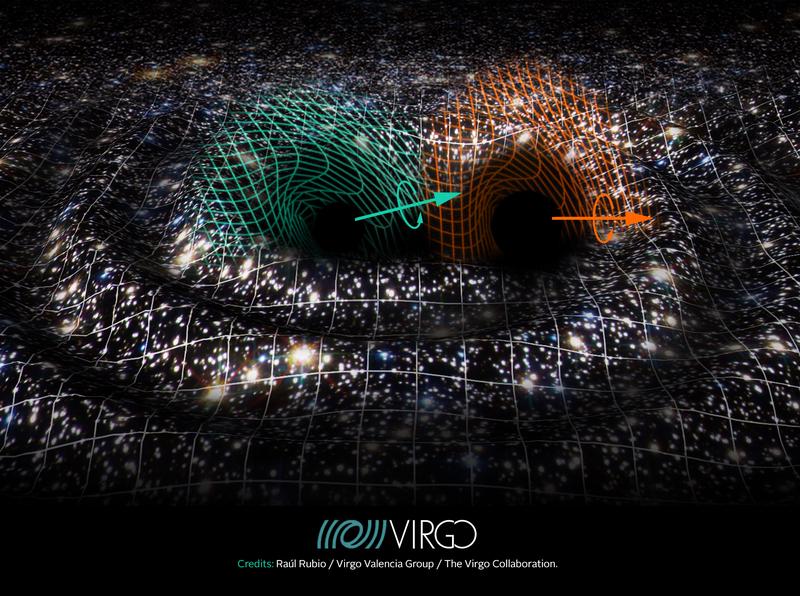Highlight
Virgo and LIGO unveil new and unexpected black hole populations
September 2, 2020

The scientists of the international collaborations running the Advanced Virgo detector at the European Gravitational Observatory (EGO) in Italy and the two Advanced LIGOs, in the US, have announced the detection of a black hole of around 142 solar masses, which is the final result of the merger of two black holes of 66 and 85 solar masses. Both the primary components and the remnant lie in a range of mass never observed before, either via gravitational waves or with electromagnetic observations. The final black hole is the most massive ever detected with gravitational waves. The gravitational-wave event was detected by the three interferometers of the global network on the 21st of May, 2019. The signal (named GW190521) has been analysed by scientists, who have estimated the distance of the source to be about 17 billion light years from Earth. Two scientific papers reporting the discovery and its astrophysical implications have been published today on Physical Review Letters and Astrophysical Journal Letters respectively.
“The signal observed on May 21 of the past year is a very complex one and, since the detected system is so massive, we only observed it for a short time: about 0.1 s”, says Nelson Christensen, directeur de recherche CNRS, Nice, France and member of the Virgo Collaboration. “This doesn’t look much like a chirp, which is what we typically detect: it is more like something that goes ‘bang’ and the system that generated it is the most massive that LIGO and Virgo have detected until now.” Indeed, the analysis of the signal, based on a powerful suite of state-of-the-art computational and modelling tools, revealed a large amount of information about the different stages of this unique merger. The breaking of the mass record of the Virgo and LIGO observational runs is just one of the several special features that make the detection of this exceptional merger an unprecedented discovery. A crucial aspect, which particularly drew the attention of astrophysicists, is that the remnant belongs to the class of so-called ‘intermediate-mass black holes’ (from a hundred up to a hundred thousand solar masses). The interest in this black-hole population is linked to one of the most fascinating and challenging puzzles for astrophysicists and cosmologists: the origin of supermassive black holes. These giant monsters, millions to billions of times heavier than the sun and often at the centre of galaxies, may arise from the merger of ‘smaller’ intermediate-mass black holes. Until today, very few intermediate-mass black hole candidates have been identified through electromagnetic observations alone and the remnant of GW190521 is the first observation of an intermediate-mass black hole via gravitational waves. It is of even greater interest, owing to it being in the range from 100 to 1,000 solar masses, which has represented for many years a sort of “black- hole desert”, because of the paucity of candidate events within this range.

The components and the dynamics of the merging binary system of GW190521 offer extraordinary astrophysical insights. The heaviest of the two merged black holes is larger than any black hole observed so far by LIGO and Virgo and even the lightest black holes figures is among the more massive of those observed. In particular, the masses of the progenitor black holes challenge the astrophysical models describing the collapse of the heaviest stars, at the end of their lives, into black holes. According to these models, the most massive stars are completely disrupted by the supernova explosion, due to a process called pair instability, and leave behind only gas and cosmic dust. Therefore, astrophysicists would not expect to observe any black hole in the mass range between about 60 and 120 solar masses: exactly the range of mass in which the most massive component of GW190521 lies. Hence, this detection opens new perspectives on the study of massive stars and supernova mechanisms. “Several scenarios predict the formation of black holes in the so-called pair instability mass gap: they might result from the merger of smaller black holes or from the collision of (multiple) massive stars or even from more exotic processes”, says Michela Mapelli of the University and INFN of Padova, and member of the Virgo Collaboration. “However, it is also possible that we have to revise our present understanding of the final stages of the star’s life and the resulting mass constraints on black- hole formation. Either way, GW190521 is a major contribution to the study of the formation of black holes.”
In fact, the Virgo and LIGO GW190521 detection highlights the existence of black-hole populations that have never been observed before or are unexpected and, in so doing, raises intriguing new questions about their formation mechanisms. Despite the unusually short duration of the signal, which limits our ability to infer the astrophysical properties of the source, the most advanced analyses and models currently available suggest that the initial black holes had strong spins, that is to say, they were rotating rapidly. “The signal shows hints of precession, a rotation of the orbital plane produced by spins with large magnitude and particular orientation”, states Tito Dal Canton, CNRS researcher at IJCLab in Orsay, France, and member of the Virgo Collaboration. “The effect is weak and we cannot claim it is definitely present, but if true, it would support the hypothesis that the progenitor black holes arose and lived in a very shaky and crowded cosmic environment, like a dense star cluster or the accretion disk of an active galactic nucleus.” Several different scenarios are still compatible with the shown results and even the hypothesis that the progenitors of the merger might be primordial black holes has not been discarded by scientists. We actually estimate that this merger occurred about 7 billion years ago, a time close to the ancient ages of the Universe. With respect to previous gravitational-wave detections, the observed GW190521 signal is very short in time and more difficult to analyse. Due to the more complex nature of this signal other more exotic sources have been considered, and these possibilities are described in an accompanying publication. However these possibilities are disfavoured with respect to the source being a binary black hole merger. “The observations made by Virgo and LIGO are shedding light on the dark universe and defining a new cosmic landscape”, states Giovanni Losurdo, Virgo spokesperson and head of research at Istituto Nazionale di Fisica Nucleare in Italy “And today, once again, we announce an unprecedented discovery. We keep improving our detectors to enhance their performance and look further and further into the Universe.”
Additional information about the gravitational-wave observatories:
The Virgo Collaboration is currently composed of approximately 580 members from 109 institutes in 13 different countries, including Belgium, France, Germany, Greece, Hungary, Ireland, Italy, the Netherlands, Poland, Portugal, Spain, Monaco and Japan. The European Gravitational Observatory (EGO) hosts the Virgo detector near Pisa in Italy, and is funded by Centre National de la Recherche Scientifique (CNRS) in France, the Istituto Nazionale di Fisica Nucleare (INFN) in Italy, and Nikhef in the Netherlands. A list of the Virgo Collaboration groups can be found at http://public.virgo-gw.eu/the-virgo-collaboration/ . More information is available on the Virgo website at http://www.virgo-gw.eu . LIGO is funded by the National Science Foundation (NSF) and operated by Caltech and MIT, which conceived of LIGO and led the project. Financial support for the Advanced LIGO project was led by the NSF, with Germany (Max Planck Society), the U.K. (Science and Technology Facilities Council) and Australia (Australian Research Council-OzGrav) making significant commitments and contributions to the project. Approximately 1,300 scientists from around the world participate in the effort through the LIGO Scientific Collaboration, which includes the GEO Collaboration. A list of additional partners is available at https://my.ligo.org/census.php .
- Publications
- R. Abbott et al. Properties and Astrophysical Implications of the 150 M ⊙ Binary Black Hole Merger GW190521 The Astrophysical Journal Letters, Volume 900, Number 1
- R. Abbott et al. (LIGO Scientific Collaboration and Virgo Collaboration) GW190521: A Binary Black Hole Merger with a Total Mass of 150 M⊙ Phys. Rev. Lett. 125, 101102
- IFAE Research group
- Gravitational Waves Group
- Contact
